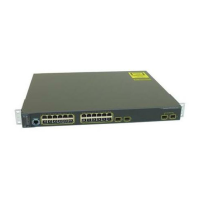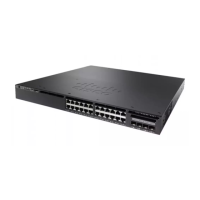Alternative Methods of Load Splitting IP Multicast Traffic
Load splitting of IP multicast traffic can also be achieved by consolidating multiple parallel links into a single
tunnel over which the multicast traffic is then routed. This method of load splitting is more complex to configure
than ECMP multicast load splitting. One such case where configuring load splitting across equal-cost paths
using GRE links can be beneficial is the case where the total number of (S, G) or (*, G) states is so small and
the bandwidth carried by each state so variable that even the manual engineering of the source or RP addresses
cannot guarantee the appropriate load splitting of the traffic.
With the availability of ECMP multicast load splitting, tunnels typically only need to be used if per-packet
load sharing is required.
Note
IP multicast traffic can also be used to load split across bundle interfaces, such as Fast or Gigabit EtherChannel
interfaces, MLPPP link bundles or Multilink Frame Relay (FRF.16) bundles. GRE or other type of tunnels
can also constitute such forms of Layer 2 link bundles. Before using such an Layer 2 mechanism, it is necessary
to understand how unicast and multicast traffic is load split.
Before load splitting IP multicast traffic across equal-cost paths over a tunnel, you must configure CEF
per-packet load balancing or else the GRE packets will not be load balanced per packet.
How to Load Split IP Multicast Traffic over ECMP
Enabling ECMP Multicast Load Splitting
Perform the following tasks to load split IP multicast traffic across multiple equal-cost paths, based on source
address.
If two or more equal-cost paths from a source are available, unicast traffic will be load split across those paths.
However, by default, multicast traffic is not load split across multiple equal-cost paths. In general, multicast
traffic flows down from the RPF neighbor. According to PIM specifications, this neighbor must have the
highest IP address if more than one neighbor has the same metric.
Configuring load splitting with the ip multicast multipath command causes the system to load split multicast
traffic across multiple equal-cost paths based on source address using the S-hash algorithm. When the ip
multicast multipath command is configured and multiple equal-cost paths exist, the path in which multicast
traffic will travel is selected based on the source IP address. Multicast traffic from different sources will be
load split across the different equal-cost paths. Load splitting will not occur across equal-cost paths for multicast
traffic from the same source sent to different multicast groups.
The ip multicast multipathcommand load splits the traffic and does not load balance the traffic. Traffic
from a source will use only one path, even if the traffic far outweighs traffic from other sources.
Note
IP Multicast Routing Configuration Guide, Cisco IOS XE Release 3.6E (Catalyst 3850 Switches)
360 OL-32598-01
IP Multicast Optimization: IP Multicast Load Splitting across Equal-Cost Paths
How to Load Split IP Multicast Traffic over ECMP
